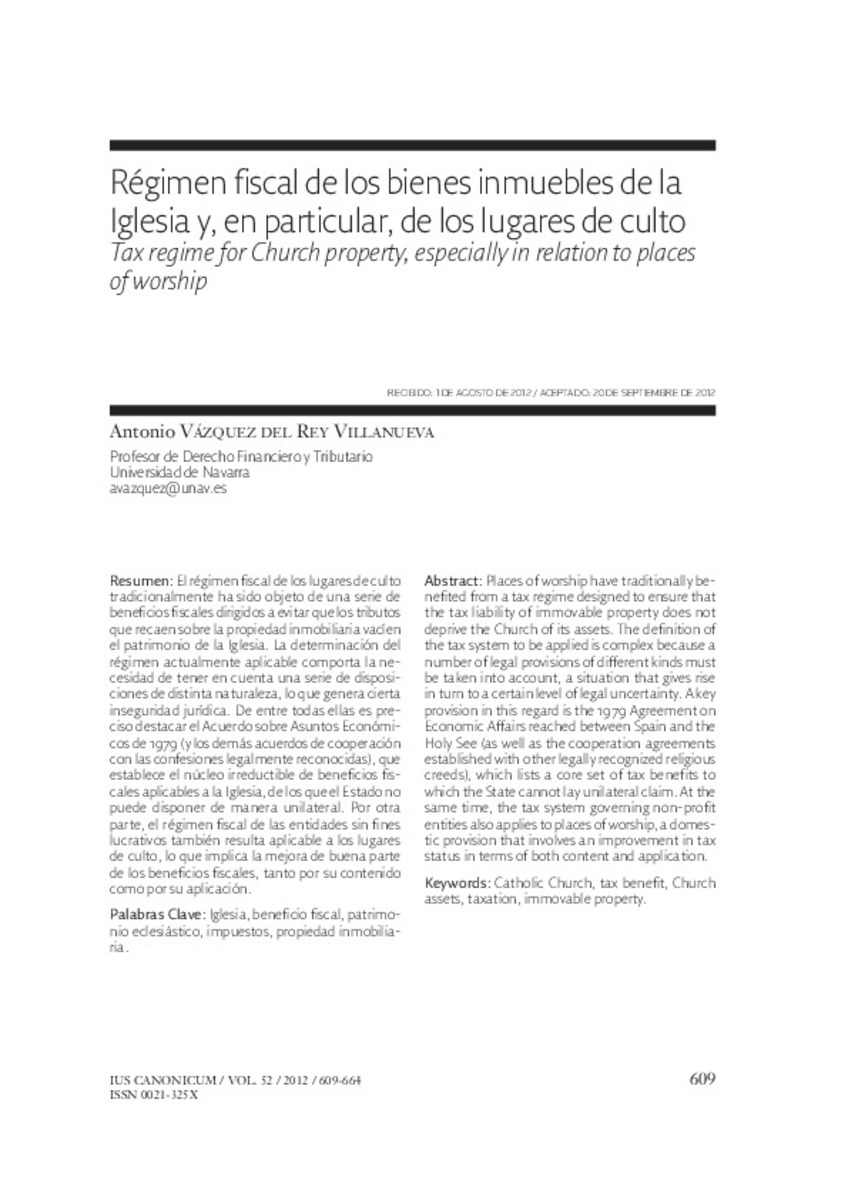Full metadata record
| DC Field | Value | Language |
|---|---|---|
| dc.creator | Vázquez-del-Rey-Villanueva, A. (Antonio) | - |
| dc.date.accessioned | 2016-03-10T16:49:12Z | - |
| dc.date.available | 2016-03-10T16:49:12Z | - |
| dc.date.issued | 2012 | - |
| dc.identifier.citation | IUS CANONICUM, 2012, 52, N. 104, págs. 609-663. | es_ES |
| dc.identifier.issn | 0021-325X | - |
| dc.identifier.uri | https://hdl.handle.net/10171/40172 | - |
| dc.description.abstract | El régimen fiscal de los lugares de culto tradicionalmente ha sido objeto de una serie de beneficios fiscales dirigidos a evitar que los tributos que recaen sobre la propiedad inmobiliaria vacíen el patrimonio de la Iglesia. La determinación del régimen actualmente aplicable comporta la necesidad de tener en cuenta una serie de disposiciones de distinta naturaleza, lo que genera cierta inseguridad jurídica. De entre todas ellas es preciso destacar el Acuerdo sobre Asuntos Económicos de 1979 (y los demás acuerdos de cooperación con las confesiones legalmente reconocidas), que establece el núcleo irreductible de beneficios fiscales aplicables a la Iglesia, de los que el Estado no puede disponer de manera unilateral. Por otra parte, el régimen fiscal de las entidades sin fines lucrativos también resulta aplicable a los lugares de culto, lo que implica la mejora de buena parte de los beneficios fiscales, tanto por su contenido como por su aplicación. | es_ES |
| dc.description.abstract | Places of worship have traditionally benefited from a tax regime designed to ensure that the tax liability of immovable property does not deprive the Church of its assets. The definition of the tax system to be applied is complex because a number of legal provisions of different kinds must be taken into account, a situation that gives rise in turn to a certain level of legal uncertainty. A key provision in this regard is the 1979 Agreement on Economic Affairs reached between Spain and the Holy See (as well as the cooperation agreements established with other legally recognized religious creeds), which lists a core set of tax benefits to which the State cannot lay unilateral claim. At the same time, the tax system governing non-profit entities also applies to places of worship, a domestic provision that involves an improvement in tax status in terms of both content and application. | es_ES |
| dc.language.iso | spa | es_ES |
| dc.publisher | Servicio de Publicaciones de la Universidad de Navarra | es_ES |
| dc.rights | info:eu-repo/semantics/openAccess | es_ES |
| dc.subject | Materias Investigacion::Derecho canónico | es_ES |
| dc.subject | Iglesia | es_ES |
| dc.subject | Beneficio fiscal | es_ES |
| dc.subject | Patrimonio eclesiástico | es_ES |
| dc.subject | Impuestos | es_ES |
| dc.subject | Propiedad inmobiliaria | es_ES |
| dc.subject | Catholic Church | es_ES |
| dc.subject | Tax benefit | es_ES |
| dc.subject | Church assets | es_ES |
| dc.subject | Taxation | es_ES |
| dc.subject | Immovable property | es_ES |
| dc.title | Régimen fiscal de los bienes inmuebles de la Iglesia y, en particular, de los lugares de culto | es_ES |
| dc.title.alternative | Tax regime for Church property, especially in relation to places of worship | es_ES |
| dc.type | info:eu-repo/semantics/article | es_ES |
| dc.identifier.doi | 10.15581/016.52.453 | es_ES |
Files in This Item:
Statistics and impact
Items in Dadun are protected by copyright, with all rights reserved, unless otherwise indicated.






